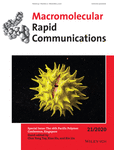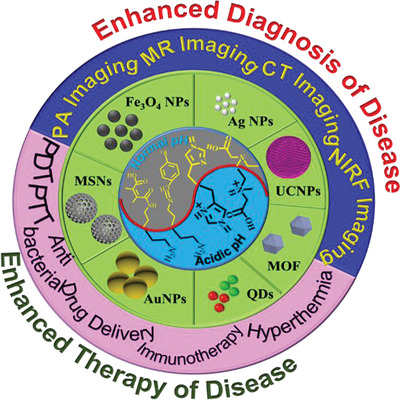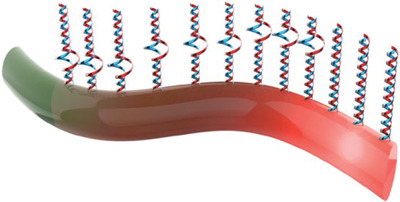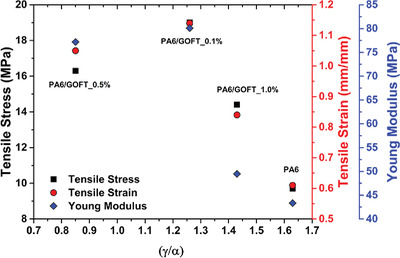Journal list menu
Export Citations
Download PDFs
Cover Picture
Influence of Chemical and Physical Change of Pollen Microgels on Swelling/De-Swelling Behavior
- First Published: 05 November 2020
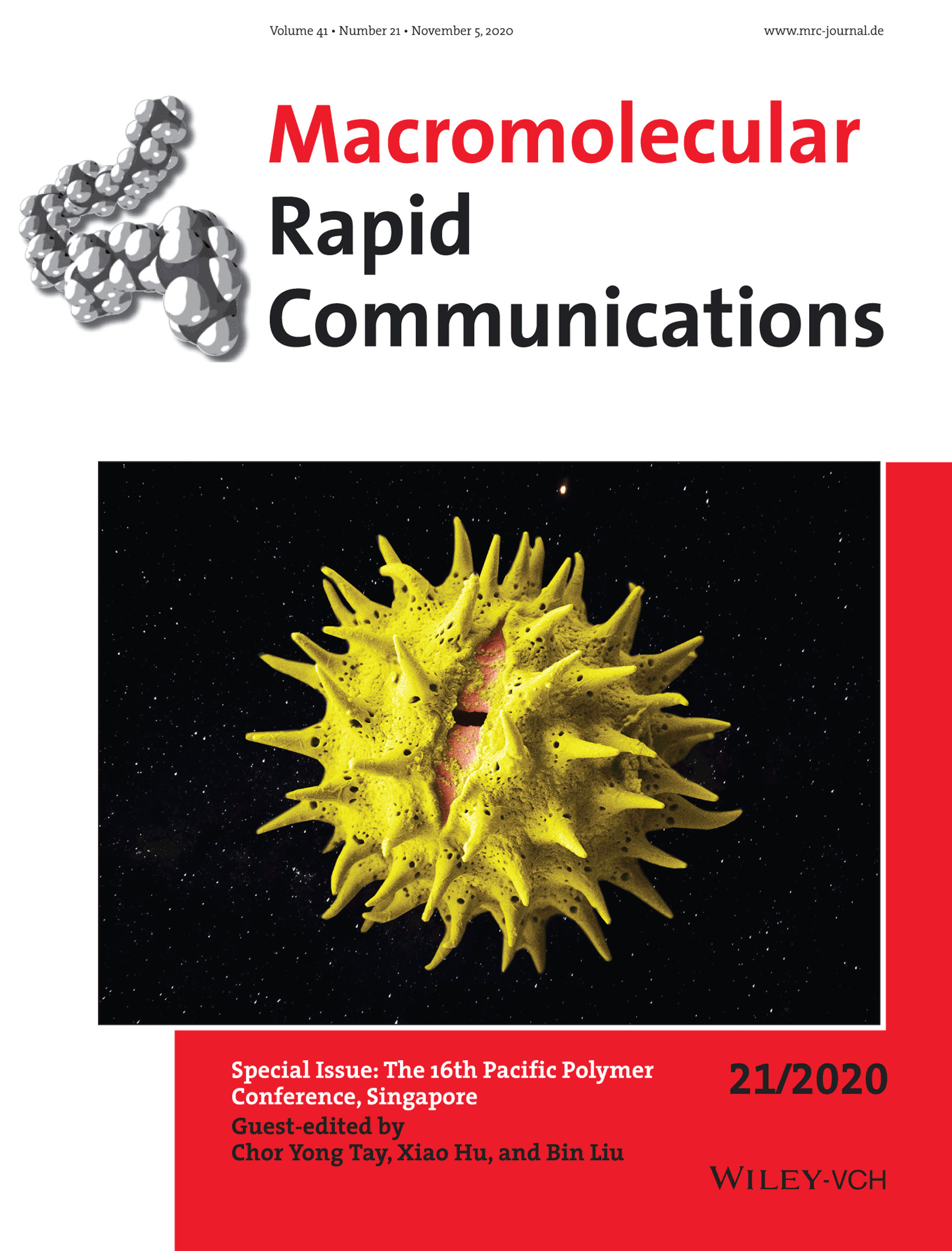
Front Cover: In article number 2000155 by Nam-Joon Cho and co-workers, sunflower pollen grains are transformed into soft materials— pollen microgels—for high processability by the soap-making method. The physical and chemical properties of the sunflower pollen microgel are investigated for different potassium hydroxide concentrations and incubation times.
Masthead
Editorial
Forging New Frontiers in Polymer Research and Innovations
- First Published: 05 November 2020
Reviews
Recent Advances of pH-Induced Charge-Convertible Polymer-Mediated Inorganic Nanoparticles for Biomedical Applications
- First Published: 06 May 2020
Recent Advances in Complex Coacervation Design from Macromolecular Assemblies and Emerging Applications
- First Published: 20 May 2020
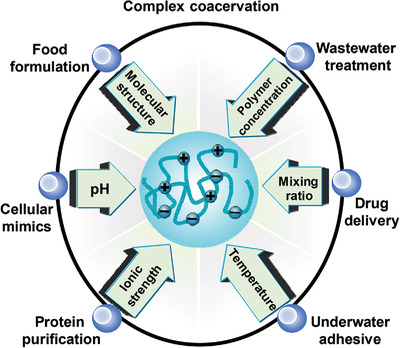
A comprehensive overview of recent work on complex coacervation from macromolecular assemblies, with a focus on coacervate mechanics, design strategies, and influence factors on their formation, is provided. Furthermore, recent achievements on representative applications of coacervate-based materials in a broad range of fields are highlighted.
Nano–Micro Dimensional Structures of Fiber-Shaped Luminous Halide Perovskite Composites for Photonic and Optoelectronic Applications
- First Published: 01 July 2020

Fiber-shaped halide perovskite composites offer excellent luminescent properties with color tunability and emission efficiency for optoelectronic and photonic applications. In addition, composite fibers possess high ambient and mechanical stability, promoting their applications in stretchable/flexible devices. This review highlights the fabrication, morphology, properties, and applications of halide perovskite/polymer composite fibers.
Feature Articles
Influence of Chemical and Physical Change of Pollen Microgels on Swelling/De-Swelling Behavior
- First Published: 06 July 2020
Novel Antimicrobial Coating on Silicone Contact Lens Using Glycidyl Methacrylate and Polyethyleneimine Based Polymers
- First Published: 16 August 2020
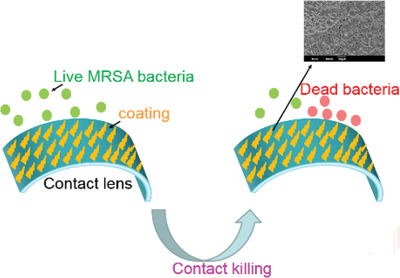
Efficient antimicrobial coatings on silicone contact lenses are realized by using glycidyl methacrylate, N-(3-sulfopropyl)-N-(methacryloxyethyl)-N,N-dimethylammonium betaine, and polyethyleneimine. The resultant coating shows effective in vitro antibacterial activity against methicillin-resistant Staphylococcus aureus bacteria with killing efficacy >99.99% and cell viability of 90%.
Functional Polymers and Polymer–Dye Composites for Food Sensing
- First Published: 25 August 2020
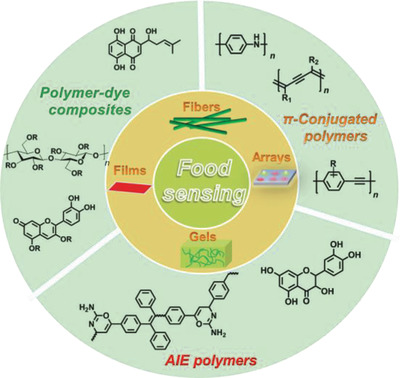
In this feature article, the recent progress on the design and fabrication of functional polymer-based sensors for monitoring food spoilage is reviewed. Functional polymeric systems, including polymer-dye composites, π-conjugated polymers, polymers with aggregation-induced emission, and polymer-grafted surfaces, have shown great potential for the development of food sensors.
Communications
Effect of Molecular Architecture on Conformational Relaxation of Polymer Chains at Interfaces
- First Published: 27 May 2020

An effect of molecular architecture on the relaxation dynamics of polystyrene chains at the quartz interface is examined using sum-frequency generation (SFG) spectroscopy. Star-shaped polystyrene in direct contact with the interface relaxes more slowly than its linear counterpart, and the extent of the slow-down increases with increasing arm functionality.
Synthesis of Polymeric Janus Superstructures via a Facile Synthesis Method
- First Published: 25 May 2020
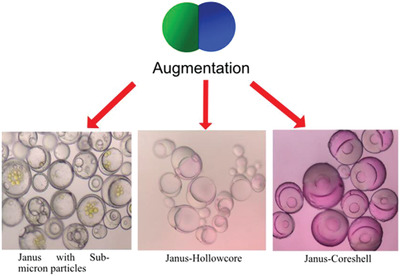
Polymeric Janus particles are two-faced entities comprised of two separate polymer faces cojoined at the bifurcation interface. Here, the augmentation of conventional Janus particles into Janus superstructures is showcased. These superstructures, namely Janus-core–shell, Janus-hollowcore, and Janus with sub-micrometer particles, can be obtained through simple tweaks of a scalable, facile, one-step solvent emulsion technique.
Solution-Processable Copolymers Based on Triphenylamine and 3,4-Ethylenedioxythiophene: Facile Synthesis and Multielectrochromism
- First Published: 24 June 2020
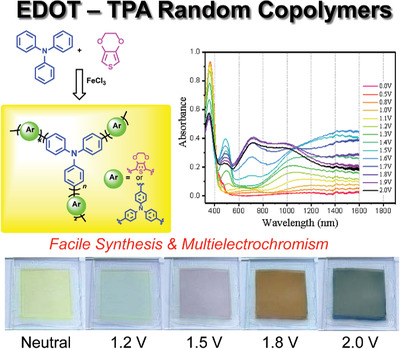
A series of hyper-branched copolymers composed of triphenylamine and 3,4-ethylenedioxythiophene are readily synthesized via FeCl3-mediated oxidative polymerization. The polymers exhibit multielectrochromism with five colored states by applying an external voltage between 0 and 2.0 V, and their corresponding electrochromic devices are stable with limited degradation upon 2500 cycles.
Zwitterionic Polymer-Grafted Superhydrophilic and Superoleophobic Silk Fabrics for Anti-Oil Applications
- First Published: 20 May 2020
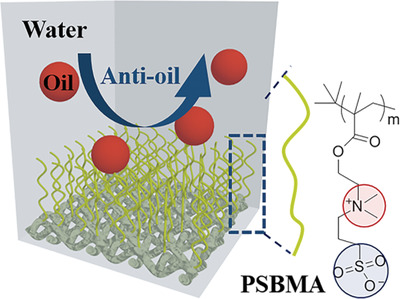
A highly anti-oil fabric membrane is developed by surface grafting of zwitterionic poly(sulfobetaine methacrylate) (PSBMA) onto enzymatically modified fabric surface via surface-initiated atom transfer radical. The PSBMA-modified fabric membrane exhibits increased surface roughness and improved superhydrophilicity. The fabrics also show excellent oil resistance in air and in water–oil mixtures.
Photoluminescent Response of Poly(3-methylthiophene)-DNA Single Nanowire Correlating to Nucleotide-Mismatch Locus in DNA–DNA Hybridization
- First Published: 24 June 2020
Influence of Alkyl Substitution Position on Wide-Bandgap Polymers in High-Efficiency Nonfullerene Polymer Solar Cells
- First Published: 09 August 2020
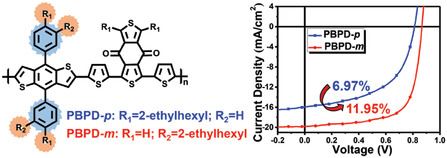
Two wide bandgap conjugated polymers PBPD-p and PBPD-m with alkyl side chains substituted at the para-position and meta-position, respectively, are synthesized. Compared with PBPD-p, the devices based on PBPD-m exhibit a higher efficiency of 11.95% with increased open-circuit voltage, short-circuit current density, and fill factor, simultaneously.
Structure–Activity Relationships of Voltaglue Organic Blends
- First Published: 16 June 2020
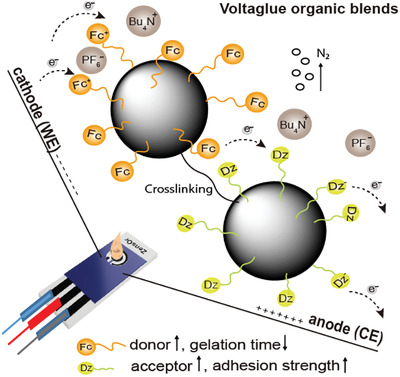
Voltage-activated adhesives formulated through a rapid blending of donor–acceptor dendrimer grafts reveal that gelation time inversely correlates with ferrocene (donor) grafting while adhesion strength correlates with the diazirine (acceptor) crosslinker. Organic blending expands the structure–activity parameter space with comparable adhesion strength to cograft strategies. This expands the opportunities of Voltaglue through multifactorial donor–acceptor libraries .
The Role of α, γ, and Metastable Polymorphs on Electrospun Polyamide 6/Functionalized Graphene Oxide
- First Published: 11 June 2020
Design Rationale for Stimuli-Responsive, Semi-interpenetrating Polymer Network Hydrogels–A Quantitative Approach
- First Published: 26 June 2020
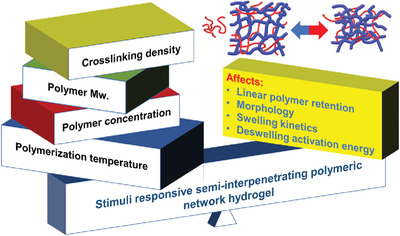
Based on a model semi-interpenetrating polymer network hydrogel system, a systematic and quantitative study on linear polymer retention within a thermally responsive crosslinked polymeric network is explored. The study provides insight on the affecting design parameters, both structural and synthetic. By the determination of kinetic swelling/deswelling rate constants, the impact of polymer retention on physicochemical properties of the gel is further elucidated.
In Vitro Biocompatibility of Diazirine-Grafted Biomaterials
- First Published: 22 September 2020
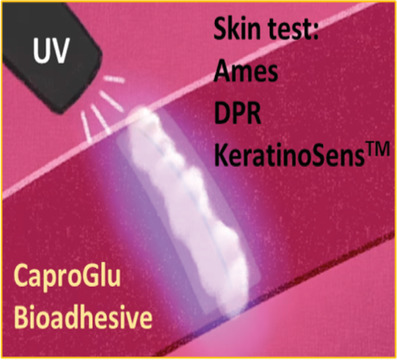
Aryl-diazirines are an emerging strategy to induce rapid covalent crosslinking and polymerization under ambient conditions upon light and voltage activation. Aryl-diazirine-grafted polyester, CaproGlu, rapidly undergoes liquid-to-elastomer transition with low-energy UVA activation. Hydrolyzed leachates from CaproGlu are assessed for genotoxic and sensitization risks with respect to UVA dose and degree of hydrolysis. Biocompatibility results compare favorably to the nontoxic, polycaprolactone tetrol.
Visible Light—Responsive Drug Delivery Nanoparticle via Donor–Acceptor Stenhouse Adducts (DASA)
- First Published: 09 August 2020
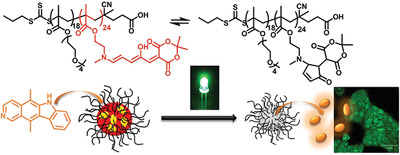
Conjugation of donor–acceptor Stenhouse adducts to block copolymers enables the formation of light-responsive micelles for drug delivery. The release of the anti-cancer drug ellipticine can be monitored in vitro as the fluorescence of the drug is quenched inside the micelle, but it is brightly fluorescent after release, which is triggered by green light-emitting diode light.
Elucidating the Role of Interfacial Hydrogen Bonds on Glass Transition Temperature Change in a Poly(Vinyl Alcohol)/SiO2 Polymer-Nanocomposite by Noncovalent Interaction Characterization and Atomistic Molecular Dynamics Simulations
- First Published: 11 September 2020
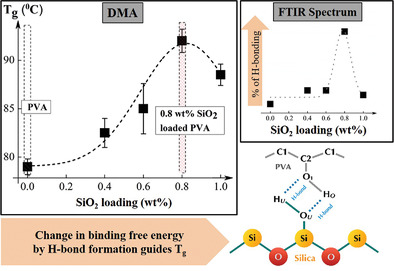
Theoretically and experimentally deduced glass transition temperature, Tg, shows direct correlation with hydrogen bonding interactions between nanoparticle surface groups and the groups on the polymer in the nanocomposite as shown by the deconvolution analysis of FTIR data. A maximum limit to this effect of Tg increase can be attributed to the overcrowding effect caused by an overload of silica nanoparticle.
UCST-Type Copolymer through the Combination of Water-Soluble Polyacrylamide and Polycaprolactone-Like Polyester
- First Published: 24 August 2020
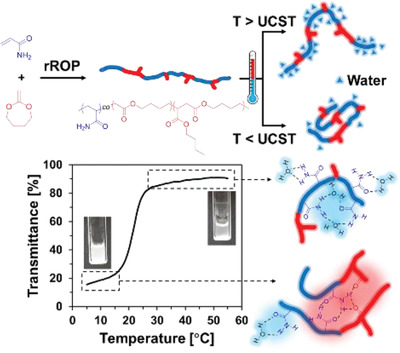
A new type of copolymer with a combination between polyacrylamide (PAAm) and PCL-like poly(2-methylene-1,3-dioxepane) (PMDO) expresses the UCST behavior in aqueous system. The utilization of radical ring opening polymerization is the key to access the copolymer of hydrophilic PAAm and hydrophobic PMDO which shows composition dependence phase-transition temperature.
Cryogelation of Human Hair Keratins
- First Published: 09 August 2020
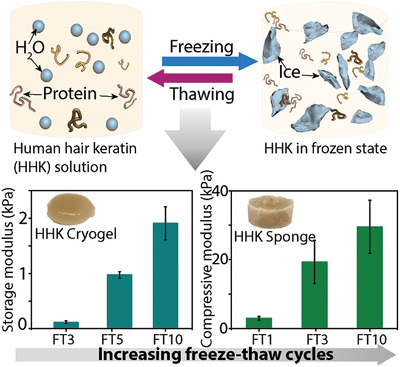
Purified human hair keratin intermediate filament proteins crosslink naturally when subjected to successive freeze–thaw cycles (cryogelation) and are able to form 3D porous scaffolds. Modulation of cryogelation parameters such as the freezing and thawing temperature and number of freeze–thaw cycles enables tunable scaffold properties. Combined with the biocompatibility of keratin, these scaffolds can be potentially used in biomedical applications.
Interpenetrating Network of Alginate–Human Adipose Extracellular Matrix Hydrogel for Islet Cells Encapsulation
- First Published: 19 August 2020
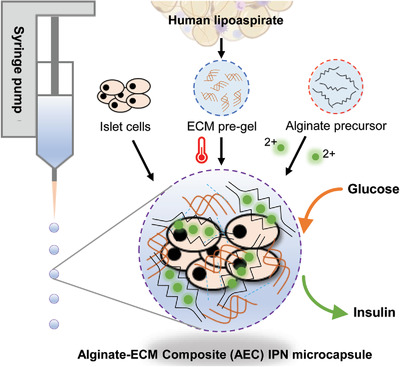
The development of a novel interpenetrating polymer networks hydrogel comprising alginate enriched with lipoaspirate-derived extracellular matrix serves as a promising biomimetic microencapsulant platform for the treatment of type 1 diabetes mellitus with improved viability, growth, and glucose response of the encapsulated islet cells, and amenable for other cell-based therapies.
Effect of Chain-End Chemistries on the Efficiency of Coupling Antibodies to Polymers Using Unnatural Amino Acids
- First Published: 16 September 2020
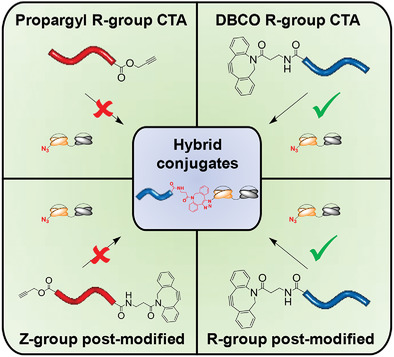
Three cycloaddition strategies for antibody conjugation to polymeric carriers are explored, showing there is a trade-off between coupling efficiency of the antibody and the ability to synthesize polymers with controlled chemical properties. Ultimately, radical-based polymerization and strained alkyne functionality need to be segregated from one another in order to achieve high functional alkyne content.




